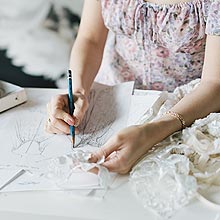The Bridal Designer’s Guide to Wedding Dress Fabrics
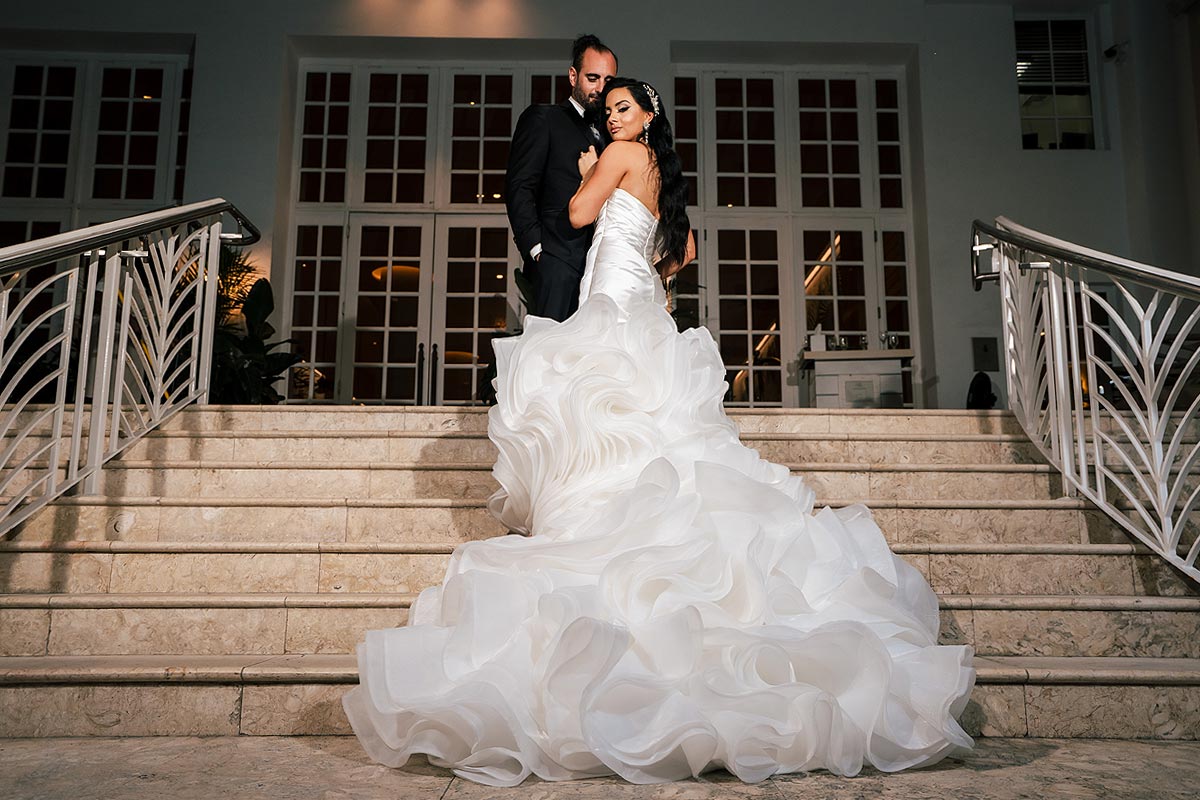
In the quest to find or create the perfect wedding dress, selecting the right fabric is often a journey in itself, one that requires a delicate balance of aesthetics, comfort, and practicality. As a custom wedding dress designer, one of the most important parts of my work is to help my brides find the perfect fabric to bring their dream dresses to life.
In this article, I’ll share my expert advice about how to choose appropriate types of fabric for your bridal gown, as well as consider the characteristics and advantages of several of the most popular bridal fabrics.
How to Choose the Perfect Wedding Dress Fabric
If you already have some wedding dress shopping experience, then you know that choosing the perfect fabric for your wedding gown can be a daunting task. With so many fabric types to choose from, it’s can be difficult to find the one that best suits your style, comfort, and budget. Here are a few things to keep in mind.
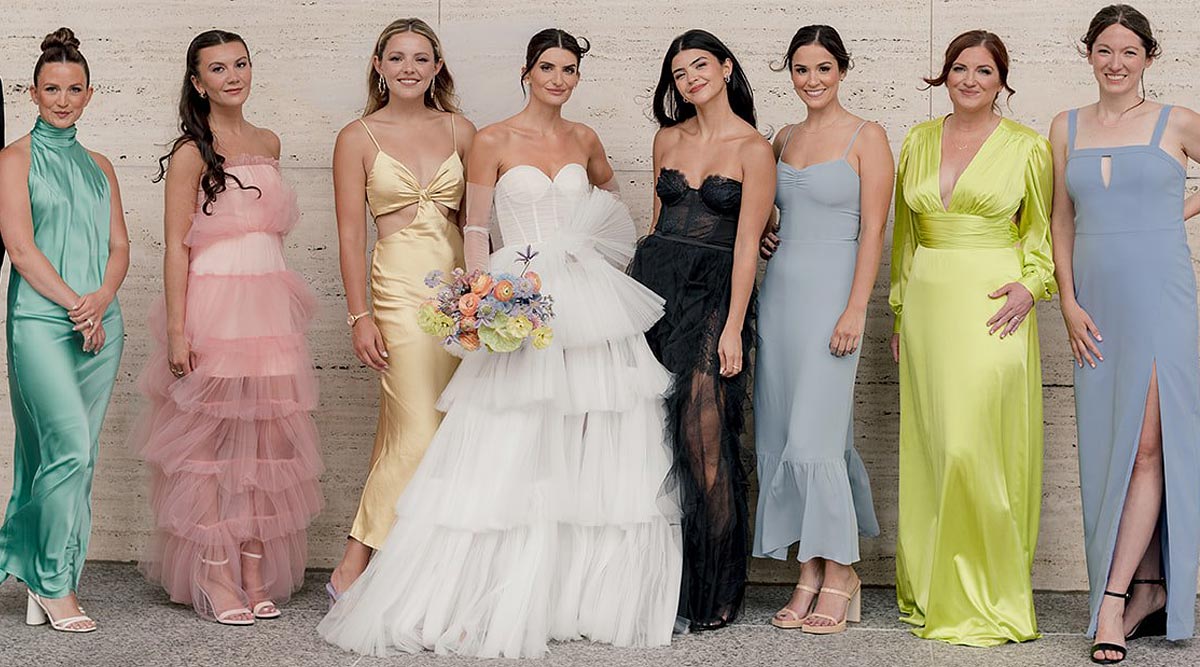
Consider the venue and theme of your wedding day. Whether it’s a hotel ballroom ceremony, an outdoor garden celebration, or an intimate beach gathering, the fabric should be appropriate for the mood you wish to create. The fabric’s texture and weight play important roles. For example, delicate laces and ethereal tulle evoke romanticism, while silk and satin exude elegance.
Consider the climate of your wedding venue and the time of year to choose a fabric that keeps you comfortable throughout the day. The season not only influences your comfort but also contributes to the overall aesthetic of your wedding ceremony, making it crucial to harmonize your fabric selection with the unique ambiance of your chosen time of year.
For spring and summer weddings, lightweight and breathable fabrics like silk chiffon or organza ensure comfort in warmer temperatures. Fall and winter weddings call for heavier fabrics like satin or velvet, which offer both warmth and elegance.
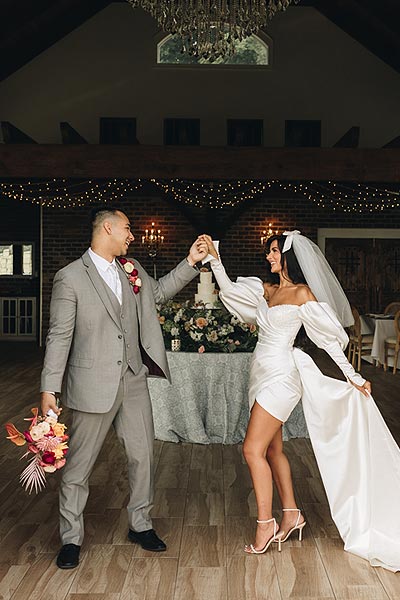
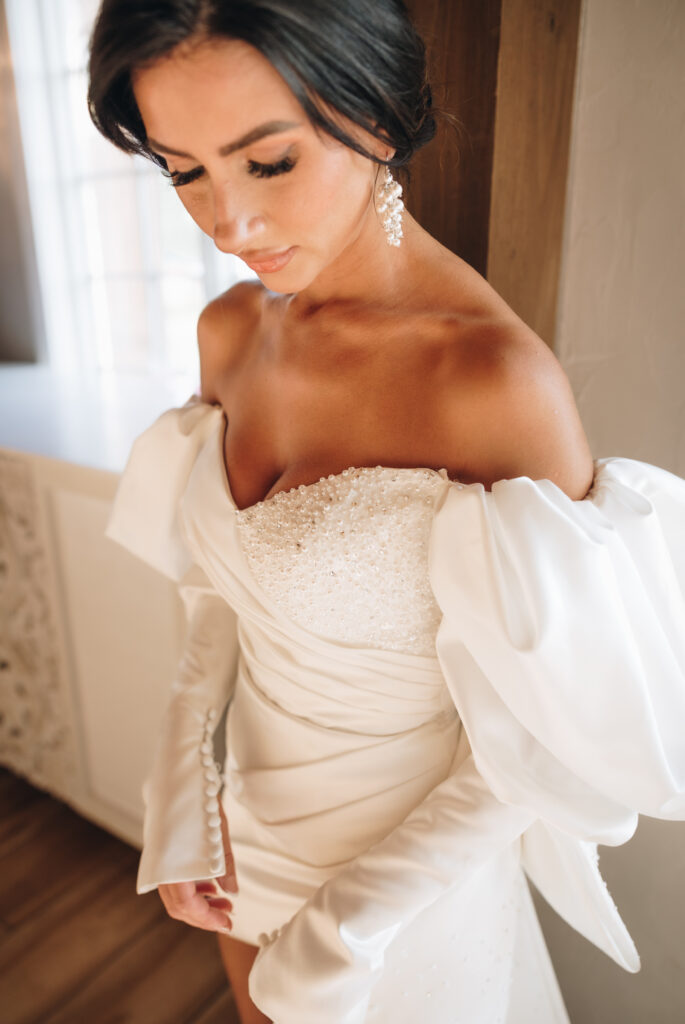
Understanding your body type and personal comfort is especially important. Some fabrics drape elegantly, while others offer more structure. Finding the balance that flatters your shape and ensures ease of movement is critical.
Additionally, consider how the fabric will look in photographs. Some materials catch light beautifully, enhancing the radiance of your dress in pictures.
Practicality should not be overlooked either — fabrics that resist wrinkles and are easy to transport can ease pre-wedding stress.
Your chosen fabric’s care requirements and durability are integral, as they impact the gown’s longevity and preservation as a cherished memento.
Lastly, remember that your budget will influence the fabric selection. While luxurious options exist, more affordable alternatives can still provide an exquisite look.
Popular Wedding Dress Fabrics and Materials
Tulle
Tulle is a versatile and lightweight fabric that adds an ethereal and romantic touch to any bridal gown. It is characterized by its sheer, gauzy netting and soft, flowing layers. It is made from silk or synthetic fibers like nylon, rayon or polyester.
Tulle lends itself well to various styles and embellishments, allowing designers to create intricate ruched details and cascading layers. For ball gown style skirts, tulle petticoats can be worn underneath the dress to add volume without too much weight.
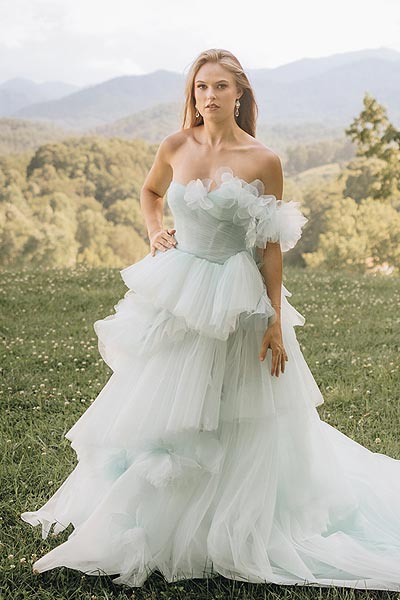
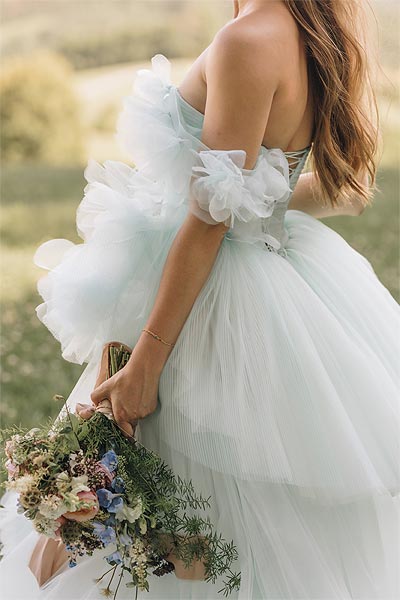
Tulle is also the classic fabric choice to create a bridal veil.
This fabric is commonly paired with other materials such as satin or lace, adding dimension and elegance to the overall design of your gown. Brides love the way this lightweight fabric effortlessly glides and floats, giving them a fairytale-like experience on their special day.
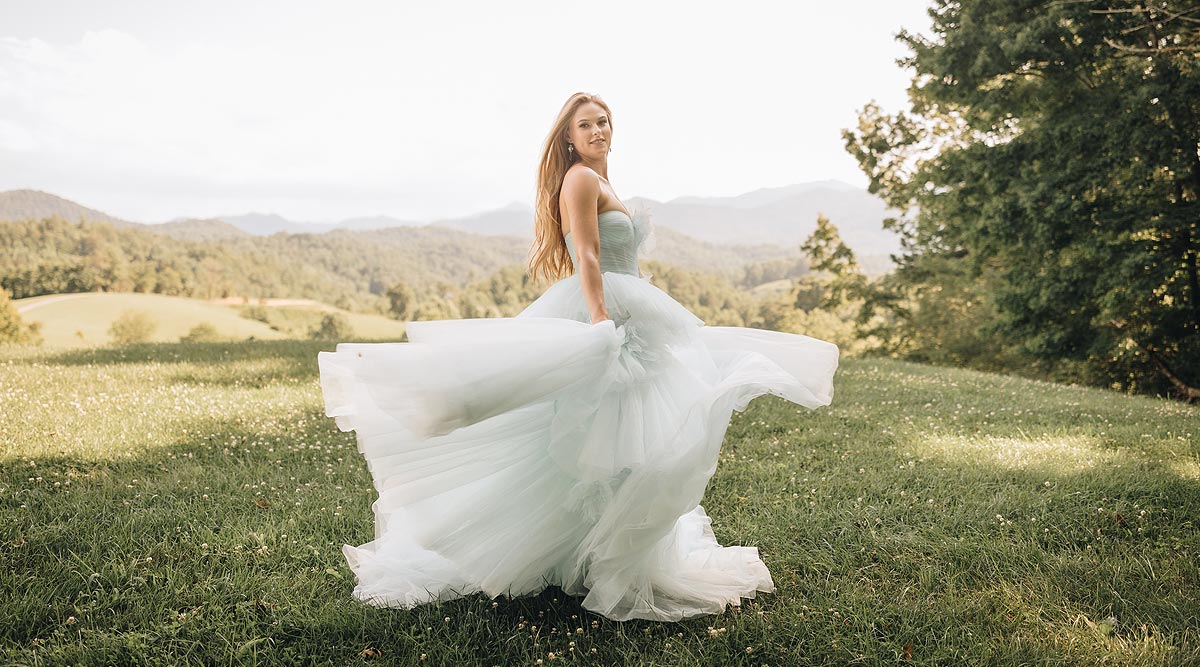
Additionally, tulle is relatively inexpensive compared to other fabrics commonly used in bridal gowns, making it a budget-friendly choice for many brides-to-be.
Crepe
Crepe is a matte fabric made of soft silk or other synthetic fibers like rayon. This delicate fabric effortlessly hugs the bride’s figure, accentuating her curves in the right places. The flowy nature of crepe fabric is ideal for soft silhouettes like mermaid or A-line designs. It also works well for minimalist styles without much structure, like sheath gowns and bridal jumpsuits.
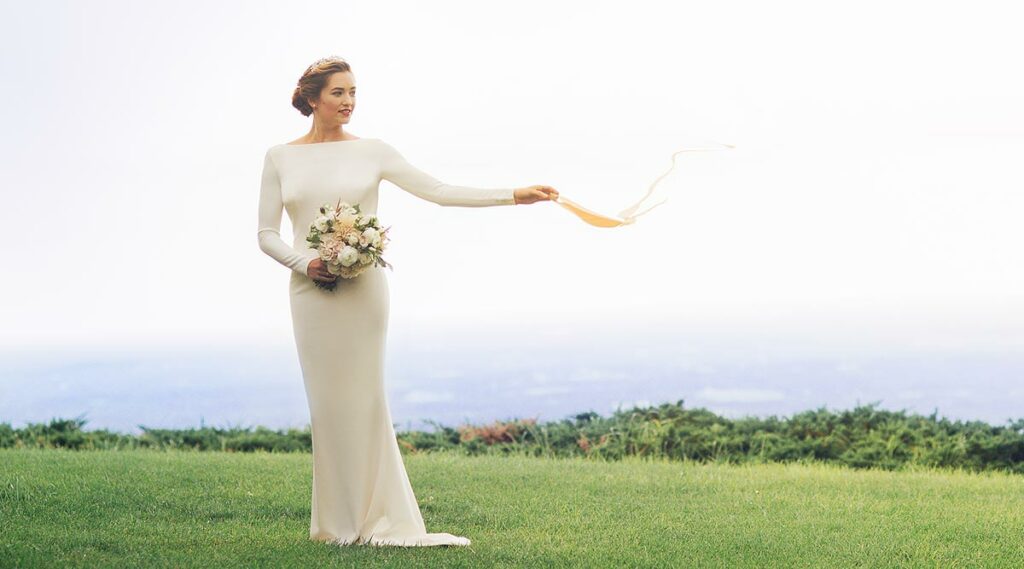
One of the most appealing characteristics of crepe is its matte finish, which gives the dress an elegant and sophisticated vibe.
With its effortlessly chic appeal, it’s no wonder crepe remains a popular choice for the modern bride looking for a wedding dress that embodies both grace and glamour.
Silk
Silk fabrics are made of natural fibers sourced from silkworm cocoons. These fibers are spun into thread and woven into cloth.
Silk fabric is characterized by its luxurious shine and delicate feel, and has long been considered the epitome of elegance in the world of wedding dress fabrics. Despite being notoriously expensive, silk continues to be a popular choice for brides who want to embody sophistication and grace on their Big Day.
There are different types of silk that make for exquisite wedding dresses. Charmeuse is a lightweight silk with a lustrous sheen and drape. It creates a fluid silhouette that beautifully enhances a bride’s figure. Taffeta, on the other hand, is favored for its crisp texture and ability to hold its shape, making it ideal for structured gowns. Silk satin is another popular option, providing a luxurious glossy finish that exudes opulence and luxury.
Mikado
Mikado is a luxurious fabric preferred for its ability to create highly structured designs. Its weighty, stiff texture ensures that the dress maintains its shape throughout your special day, making it especially suitable for fit-and-flare, trumpet, and A-line silhouettes.
Mikado is made from woven silk, sometimes blended with other synthetic fibers. This fabric is traditionally crafted using a twill weave technique, resulting in a diagonal grain pattern. This unique diagonal texture adds depth and visual interest to the fabric, setting it apart from other materials commonly used in wedding dresses.
Mikado is highly sought after for its distinctly lustrous shine. The luxurious appearance of mikado fabric creates an aura of sophistication and luxury, elevating your overall bridal look.
Satin
Satin is a fabric that is woven using a complex pattern, resulting in a glossy and lustrous finish. Its luxurious appeal, exquisite pattern, and smooth finish make it a popular choice for designers and brides alike.
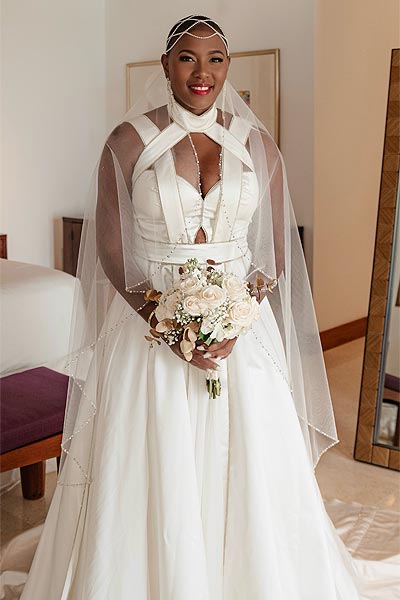
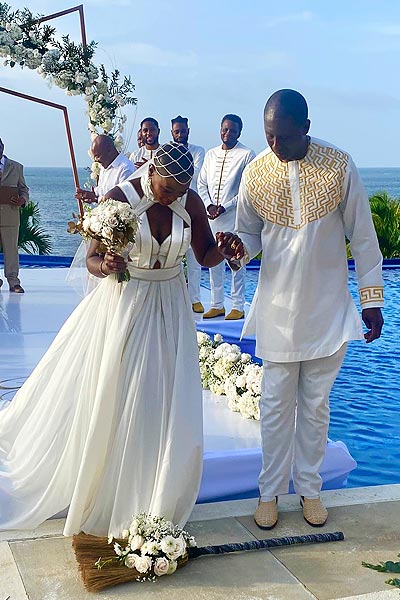
One of the most sought-after types of satin for wedding dresses is Duchess satin. This fabric offers a luxurious feel and is well-known for its draping quality. Duchess satin is often used for constructed designs and can be ruched or pleated to add dimension and texture to a wedding gown. This fabric is particularly favored for ball gown silhouettes as it gracefully flares out, creating a romantic and feminine look.
Thread count is an important factor when considering the quality of satin. A higher thread count indicates a denser and softer fabric, resulting in a more luxurious appearance.
Organza
Organza is a sheer fabric similar to tulle. Traditionally made of silk, organza holds structured shapes well. The fabric’s crisp texture allows for stunning drapes and flares, making it a perfect choice for layered and voluminous designs. Whether it is an overskirt, an A-line silhouette, or a magnificent ball gown, organza adds volume without extra weight.
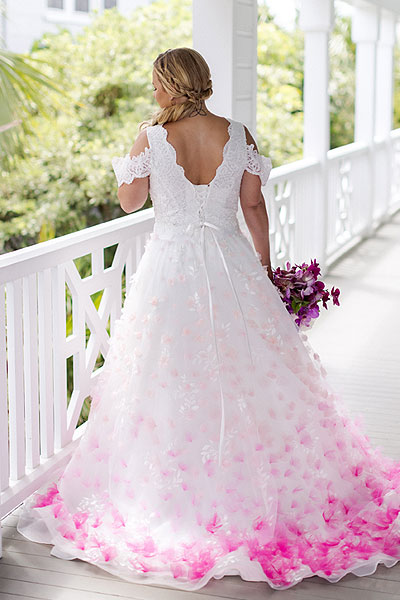
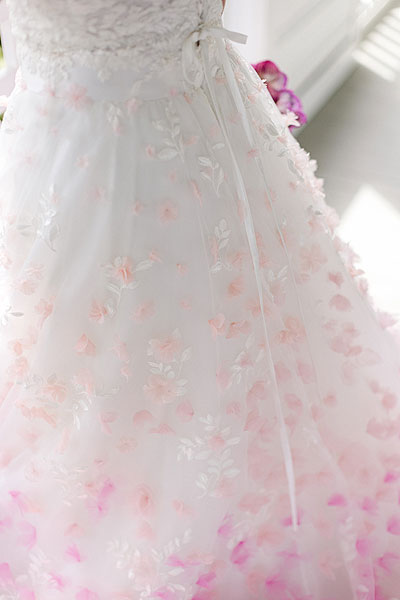
Because it is lightweight and breathable, organza is particularly suitable for outdoor weddings or events held in warm climates. The fabric allows for easy movement and ensures comfort throughout the day.
Chiffon
Chiffon is a lightweight and transparent fabric made from woven silk or synthetic fibers like rayon or nylon. The loose and open weave allows for maximum airflow, creating a fabric that effortlessly moves and flows with the bride. With delicate layers and a flowing drape, chiffon enhances the beauty and movement of a wedding gown, creating a dreamy and elegant silhouette.
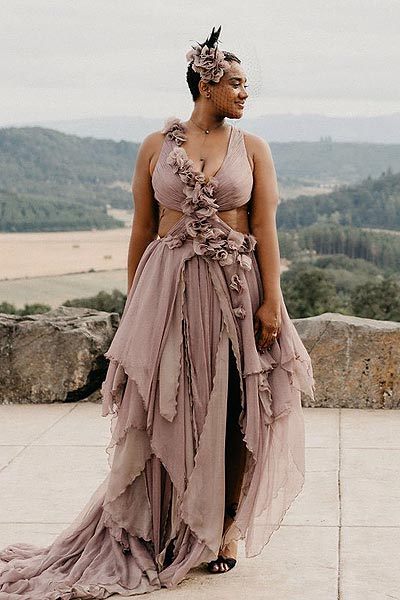
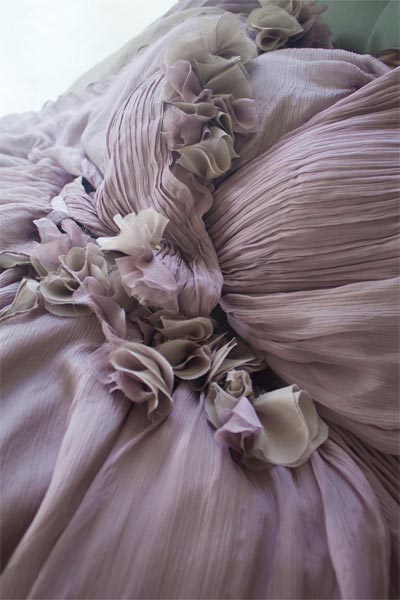
Chiffon is a great fabric choice for warmer weather ceremonies. Additionally, chiffon’s matte finish gives it a bohemian charm, making it a perfect choice for brides who want to achieve a laid-back and effortless look.
Not only a popular choice for wedding gowns, chiffon is often used for bridesmaid dresses. Its soft and flowy texture complements various body types and adds a touch of elegance to the bridal party. The versatility of chiffon allows for different styles and designs, making it possible to create a cohesive look for the entire wedding party.
Lace
Lace fabric is undoubtedly the most popular wedding dress material. It has been a staple in bridal fashion for centuries, and it continues to be a timeless favorite among brides-to-be. It is available in variety of styles, and is usually made of silk, cotton or polyester.
Whether it is used as an overlay or incorporated into the design, lace has an incredibly romantic feel, making it perfect for a wedding dress. From classic and vintage-inspired gowns to modern and bohemian designs, lace can be used to create a wide range of looks.
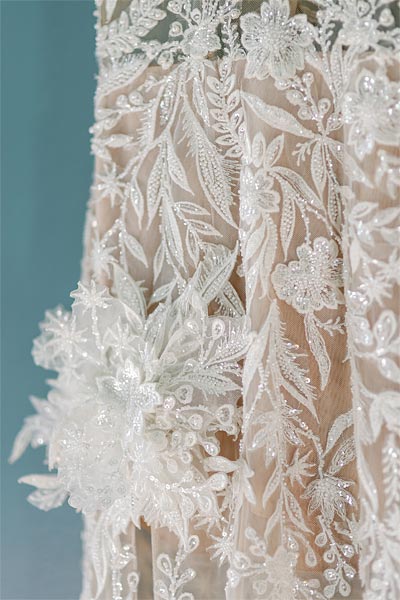
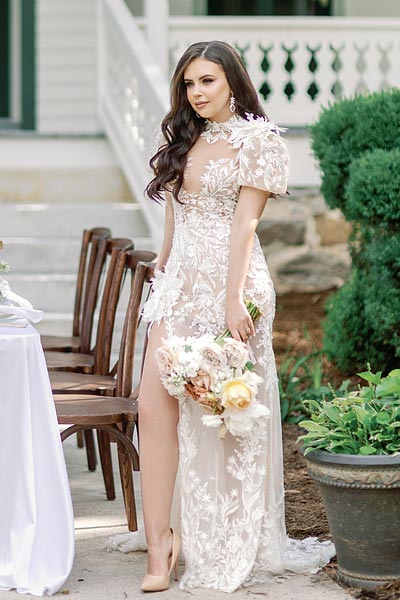
Brides can choose from different types of lace, like Chantilly, Alençon, or Guipure, each with its own unique characteristics and appeal.
Additionally, lace can be embellished with beading or embroidery, adding another layer of luxury and sophistication to a design. Beads and sequins can be delicately sewn onto the lace, creating intricate details and a subtle sparkle. Embroidery, on the other hand, can be used to create floral motifs or intricate patterns.
Shantung
Shantung features a subtle weave to create a uniquely ribbed texture. The ribbed pattern adds depth and dimension, creating a visually appealing effect that helps to hide any imperfections, making it extremely flattering on all body types.
With its medium weight and stiff drape, this fabric not only adds a luxurious shimmer to your dress that captures light beautifully, but also photographs exceptionally well. Whether it’s under natural sunlight or the flash of a camera, shantung truly shines, resulting in stunning photographs that will be cherished for years to come.
Additionally, the stiff drape lends itself well to creating voluminous skirts and structured silhouettes, creating a sense of grandeur and grace.
Another advantage of shantung is its medium weight, which strikes the perfect balance between being lightweight and substantial. Unlike flimsier fabrics, shantung holds its shape beautifully. This feature is especially beneficial for brides who want to dance the night away without worrying about their dress losing its form.


